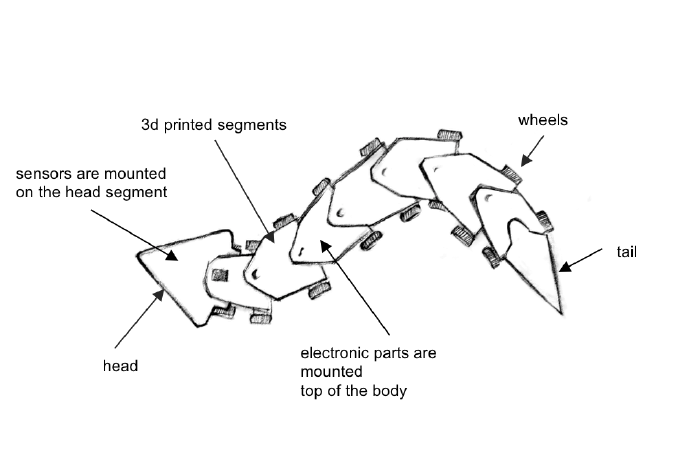No edit summary |
|||
| Line 8: | Line 8: | ||
My robot is equipped with wheels, on board processor, voltage regulator, batteries, distance sensor, color sensor, thermo sensor which allows it to locomote in a snakelike manner, find food sources (bacteria) and avoid heat. My agent wants to achieve staying alive as long as possible. Finding bacteria and avoiding heat helps it to stay alive. | My robot is equipped with wheels, on board processor, voltage regulator, batteries, distance sensor, color sensor, thermo sensor which allows it to locomote in a snakelike manner, find food sources (bacteria) and avoid heat. My agent wants to achieve staying alive as long as possible. Finding bacteria and avoiding heat helps it to stay alive. | ||
The nematode worm C. elegans is a very simple organism with some moderately complex behavior. Its primitive behaviors are feeding, reproduction and locomotion and it exhibits complex behavior such as smell/taste, touch, slight response to light, sensing temperature, robust escape responses and rudimentary learning. What is special about C. elegans is that they are among the best understood animal. Its whole genome was sequenced and it is the only creature to have had its neural system completely simulated. It has 302 neurons hard wired with around 8000 connections. [https://http://openworm.org/ Open Worm Project] | |||
Here are some microscopy images and videos I took. (will be updated shortly) | Here are some microscopy images and videos I took. (will be updated shortly) | ||
Revision as of 17:30, 28 January 2021
WORM ROBOT
Worm Robot is a bio inspired robot that simulates the neuromuscular function of a C. elegans as closely as possible. It is a bio-inspired agent to live in a simplified bio-inspired environment. The robot is trained with deep reinforcement learning which an area of machine learning concerned with how intelligent agents learn to achieve a goal in a potentially complex environment with trial and error and come up with a solution to the problem. To do this the artificial intelligence gets either rewards or penalties for the actions it performs. Its goal is to maximize the total reward.
My robot is equipped with wheels, on board processor, voltage regulator, batteries, distance sensor, color sensor, thermo sensor which allows it to locomote in a snakelike manner, find food sources (bacteria) and avoid heat. My agent wants to achieve staying alive as long as possible. Finding bacteria and avoiding heat helps it to stay alive.
The nematode worm C. elegans is a very simple organism with some moderately complex behavior. Its primitive behaviors are feeding, reproduction and locomotion and it exhibits complex behavior such as smell/taste, touch, slight response to light, sensing temperature, robust escape responses and rudimentary learning. What is special about C. elegans is that they are among the best understood animal. Its whole genome was sequenced and it is the only creature to have had its neural system completely simulated. It has 302 neurons hard wired with around 8000 connections. Open Worm Project
Here are some microscopy images and videos I took. (will be updated shortly)
